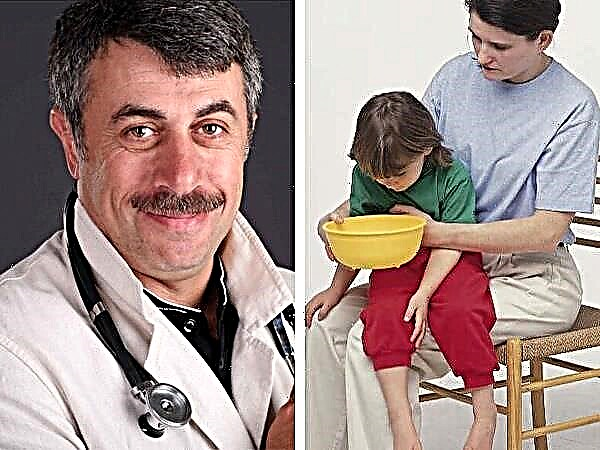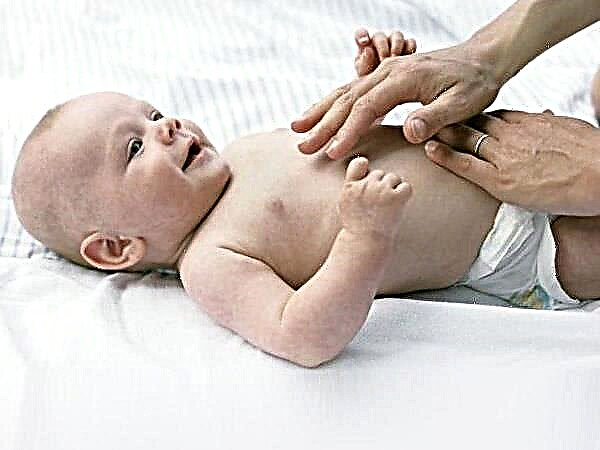Every person (both an adult and even a baby) is familiar with cough, which is one of the main manifestations of most diseases of the respiratory system. This unpleasant phenomenon, exhausting both the patient and his environment, serves as a protective mechanism. With the help of spasms resulting from irritation of the nerve endings of the mucous membrane of the larynx, trachea or bronchi, the body tries to get rid of foreign bodies. Therefore, one should fight not with the cough as such, but the cause that caused it.

Cough is a fairly common ailment in babies.
What types of cough are there
There are different classifications of cough. For example, in terms of duration, it is subdivided into:
- acute (paroxysmal, lasting a couple of weeks);
- protracted (from a crescent to a month);
- subacute (lasts up to one and a half months);
- if the baby coughs for a long time, this is a chronic cough (lasting more than two months).
It can be compared in intensity: mild coughing and tearing cough. Also, the baby may begin to bark as if, such cough sounds often accompany stenosis of the larynx with croup or false croup.
How to recognize cough symptoms yourself
It is not so difficult to determine the type of cough and its symptoms on your own; you need to carefully observe the child. So, with a viral lesion of the respiratory system, the usual cough reflex is triggered in response to irritation of the mucous membrane of the pharynx with discharge from the nose. With a runny nose, the cough is accompanied by sputum production. With false croup, the mucous membrane is affected and swollen, as a result of which the lumen of the larynx narrows, and a barking cough occurs with a wheezing breath.
Additional Information. If the inflammation has affected the bronchi and alveoli, the baby begins to cough constantly, he has shortness of breath, and the temperature may also rise. In asthmatic attacks, phlegm accumulates as a result of exposure to allergens that provoke coughing.
How is a wet cough different from a dry one?
The most popular division of types of cough is dry and wet. If during a cough attack there is no sputum separation, it is called dry, otherwise it is called wet. Most often, a dry cough accompanies the first days of the development of viral diseases, and also happens with:
- laryngitis;
- tracheitis;
- pleurisy;
- tumor diseases of the bronchi.
This type of coughing is considered unproductive, since it only further irritates the laryngeal mucosa (as well as the nerves of the patient and all households), but does not lead to cleansing.
If sputum is released (it is very desirable to expectorate), the cough is characterized as wet. Sputum is mucus that is produced on the walls of the bronchi. It is one of the symptoms of diseases of the respiratory system.
Important! The separation of sputum is a phenomenon that is designed to help clear the lungs of pathological microorganisms and destroyed epithelial cells, therefore such a cough is cured with expectorants.
Thick sputum is a substance that is very difficult to cough up, the more it is, the more “terrible” and rude the child coughs.
Common causes of coughing in babies
Causes the occurrence of cough attacks in children are varied:
- the presence of a foreign body in the larynx;
- pharyngitis - an inflammatory process in the pharynx, a characteristic onset of a cold, accompanied by a sore throat, runny nose and fever;
- laryngitis - an inflammatory process in the nasopharynx, a child's cough with laryngitis affects the vocal cords, it is dry and very sharp; the mucous membrane in this place is subject to rapid edema, attacks occur mainly at night;
- tracheitis - inflammation reaches the trachea, unproductive cough, it happens with acute respiratory infections and any childhood infections;
- whooping cough - seizures are caused by the action of toxins on the cough center in the brain; it is a long, debilitating illness;
- acute bronchitis - accompanied by a dry cough, which then turns into a wet one, as well as an increase in temperature up to 38 degrees, sweating, the child is constantly shivering;
- chronic bronchitis - "chest" cough with discharge of green sputum can last up to three months;
- pneumonia - a dry cough, which characterizes the onset of the disease, disappears within a short time, inflammation of the bronchi may join;
- bronchial asthma - accompanied by a spasm of the bronchi, in which exhalation is difficult, and inhalation of air becomes intermittent.
Cough with fever
When a child has a cough and fever, while the nose is clean, without snot, it looks like a sore throat, which at first proceeds without symptoms, and only the appearance of fever signals the disease. Then redness of the throat and swelling of the tonsils join the dry cough.

With angina, cough is accompanied by redness of the throat
Another reason that the child has a fever and coughs badly is complications after an untreated ARVI, when pathogens enter the respiratory system, and the disease turns into pneumonia or bronchitis. If the baby also falls asleep, it could be symptoms of chickenpox or rubella.
Cough without fever
In children under one year old and older, coughing attacks occur without fever (maximum - 37-37.5 degrees). For example, in case of an allergy, after contact with an allergen, a baby's throat can persist for a long time. Chronic cough at normal body temperature occurs with bronchial asthma, it is wheezing and abrupt.
Night cough
It happens that during the day the child does not complain about anything, and at night he is "covered" with coughing fits, which interfere with the proper sleep of the baby. This can be both with serious pathology of the upper respiratory tract, and the fact that mucous nasal discharge enters the pharynx and irritates it. This usually happens on awakening.
Note! Dustiness and dry air can intensify nighttime coughing.
Vomiting cough
Sometimes coughing attacks are accompanied by vomiting. This is a rather alarming symptom, it can be a sign of whooping cough, which is especially dangerous not only for newborns, but also for half-year-olds.
Sometimes even a simple "runny" cough and sneezing can provoke a gag reflex. Doctors advise to feed these babies a little, but often.
Caring for a baby from birth to a year when coughing
The first condition for proper care is consultation with a doctor, especially when the child has a severe cough. The ability to determine "by ear" its appearance will greatly help the pediatrician in making a diagnosis. A sick baby (whether it is two months old or already one year old) must be provided with peace and try to follow the doctor's recommendations.
How to stop an attack
In order to stop a dry cough, you must:
- if the child is coughing, before being treated, he must be calm, take the baby on the arms;

When a coughing attack occurs, you need to take the baby in your arms
- give a warm drink to soften mucous membranes;
- drip saline into the spout;
- increase the humidity in the room, you can sit with the little one in the bathroom;
- inhale with saline or mineral water.
It is possible to help relieve an attack with a medication only after consulting a pediatrician.
General recommendations
The main recommendation for coughing in newborns and children under the age of one year is bed rest for the whole day. It is advisable to wrap the patient in a blanket, to maintain the temperature in the room no higher than 22 degrees and high humidity.
It is necessary to observe the fluid balance: to give the baby a lot of water, tea, juice, fruit drink, you can make a homemade compote. Food should be easily digestible: soups, mashed potatoes, fruits and berries can be grated.
What not to do
One of the strict prohibitions is self-medication - you cannot decide on your own how and how to treat a cough in a baby, because there is no universal remedy, and an incorrectly chosen treatment can harm a baby.
It is undesirable to "stuff" a child with drugs, as soon as he starts to cough, because a cough can be caused by a natural cause. For example, babies under three months of age may cough when a drop of milk enters the trachea.
Neither a four-month-old nor a six-month-old baby is recommended to put mustard plasters - they can cause a burn. It is also advisable to exclude sweet and sour foods, dry crumbling foods from the diet.
Which doctor to contact
As soon as the baby has the first signs of the disease, the parents must decide which specialist to show it to. First of all, it is a pediatrician who will determine the main causes of cough and write out further directions. To clarify the diagnosis of the child, an ENT, an allergist will look. If the cough is associated with diseases in the gastrointestinal tract, a gastroenterologist will come to the rescue. When coughing attacks occur at night while lying down, it is best to show the child to a cardiologist. Sometimes a pediatrician can refer you to a pulmonologist, phthisiatrician, or oncologist.
Diagnostic methods
The first method is listening with a stethoscope. Further, depending on the cause, such diagnostic manipulations may be required as:
- fluorography;
- x-ray;

A child with a cough may need an x-ray
- physical examination;
- allergy tests;
- bronchoscopy;
- computed tomography of the lungs.
Qualitative and timely diagnostics is the key to further effective treatment.
Features of therapy in children under one year old
In order to cure a cough in babies as soon as possible, you should not delay visiting a doctor, because in children aged six months and older, inflammations very quickly bring an acute condition. The key to successful treatment is strict compliance with the pediatrician's prescriptions.
Drainage massage
A very effective remedy for relieving babies from coughing from several months to a year is drainage massage. When it is carried out, the child's head falls below the body. The movements are carried out gently and accurately. The back is first smoothed out, then tapped. Then the sides are rubbed, the third stage is breast drainage. After the massage, it is better for the patient to sleep, and it is possible until the morning.

Drainage massage
The use of inhalers, nebulizers
A good effect is given by inhalations with steam (to moisten sputum). However, if there is no dried mucus in the throat, such procedures are not at all helpful. Inhalation of fine particles of strong drugs with the help of nebulizers relieves the condition with lesions of the upper respiratory tract.
Folk remedies
Traditional medicine is considered safer and more effective. These are various inhalations with soda and iodine, as well as medicinal herbs, inhalation of potato vapors is popular.
Dry cough is treated with rinsing with soda and iodine, carrot juice with honey, decoctions of calendula, licorice and chamomile crowns. To stop inflammation, various compresses, rubbing, drinking onion-sugar syrup are used.
Medications
Cough in a month-old baby how to treat, the pediatrician decides, he can prescribe the following drugs to babies:
- mucolytics to get rid of phlegm;
- suppressing cough reflex;
- expectorant;
- antiallergic;
- antibiotics in severe cases.
Dr. Komarovsky about severe cough in babies
The well-known pediatrician Komarovsky believes that expectorant drugs should not be given to children under five months of age and a little older, they only increase the amount of mucus. To get rid of seizures as soon as possible, the doctor advises high humidity and low temperature in the room, as well as drinking plenty of fluids for the child.

Doctor Komarovsky
Preventive measures
It is easier to carry out preventive measures than to go through all the stages of subsequent treatment. These measures include:
- healthy lifestyle;
- strengthening the child's immunity;
- elimination of potential allergens.
Even ideal conditions do not provide good health, so every child faces a cough. It can be wet or dry, and vary in the reasons that caused it. Given the nuances of treating young children, it can only be started after visiting a pediatrician.



